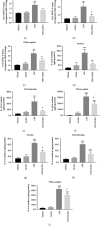Increased Soluble Epoxide Hydrolase in Human Gestational Tissues from Pregnancies Complicated by Acute Chorioamnionitis
- PMID: 31885501
- PMCID: PMC6915158
- DOI: 10.1155/2019/8687120
Increased Soluble Epoxide Hydrolase in Human Gestational Tissues from Pregnancies Complicated by Acute Chorioamnionitis
Abstract
Chorioamnionitis (CAM) is primarily a polymicrobial bacterial infection involving chorionic and amniotic membranes that is associated with increased risk of preterm delivery. Epoxyeicosatrienoic acids (EETs) are eicosanoids generated from arachidonic acid by cytochrome P450 enzymes and further metabolized mainly by soluble epoxide hydrolase (sEH) to produce dihydroxyeicosatrienoic acids (DHETs). As a consequence of this metabolism of EETs, sEH reportedly exacerbates several disease states; however, its role in CAM remains unclear. The objectives of this study were to (1) determine the localization of sEH and compare the changes it undergoes in the gestational tissues (placentas and fetal membranes) of women with normal-term pregnancies and those with pregnancies complicated by acute CAM; (2) study the effects of lipopolysaccharide (LPS) on the expression of sEH in the human gestational tissues; and (3) investigate the effect of 12-(3-adamantan-1-yl-ureido)-dodecanoic acid (AUDA), a specific sEH inhibitor, on LPS-induced changes in 14,15-DHET and cytokines such as interleukin- (IL-) 1β and IL-6 in human gestational tissues in vitro and in pregnant mice. We found that women with pregnancies complicated by acute CAM had higher levels of sEH mRNA and protein in fetal membranes and villous tissues compared to those in women with normal-term pregnancies without CAM. Furthermore, fetal membrane and villous explants treated with LPS had higher tissue levels of sEH mRNA and protein and 14,15-DHET than those present in the vehicle controls, while the administration of AUDA in the media attenuated the LPS-induced production of 14,15-DHET in tissue homogenates and IL-1β and IL-6 in the media of explant cultures. Administration of AUDA also reduced the LPS-induced changes of 14,15-DHET, IL-1β, and IL-6 in the placentas of pregnant mice. Together, these results suggest that sEH participates in the inflammatory changes in human gestational tissues in pregnancies complicated by acute CAM.
Copyright © 2019 Tai-Ho Hung et al.
Conflict of interest statement
All the authors declare that they have no conflicts of interest.
Figures







Similar articles
-
Increases in levels of epoxyeicosatrienoic and dihydroxyeicosatrienoic acids (EETs and DHETs) in liver and heart in vivo by 2,3,7,8-tetrachlorodibenzo-p-dioxin (TCDD) and in hepatic EET:DHET ratios by cotreatment with TCDD and the soluble epoxide hydrolase inhibitor AUDA.Drug Metab Dispos. 2014 Feb;42(2):294-300. doi: 10.1124/dmd.113.055368. Epub 2013 Dec 5. Drug Metab Dispos. 2014. PMID: 24311719 Free PMC article.
-
Inhibition of soluble epoxide hydrolase does not protect against endotoxin-mediated hepatic inflammation.J Pharmacol Exp Ther. 2008 Dec;327(3):707-15. doi: 10.1124/jpet.108.142398. Epub 2008 Sep 24. J Pharmacol Exp Ther. 2008. PMID: 18815352 Free PMC article.
-
Soluble epoxide hydrolase activity regulates inflammatory responses and seizure generation in two mouse models of temporal lobe epilepsy.Brain Behav Immun. 2015 Jan;43:118-29. doi: 10.1016/j.bbi.2014.07.016. Epub 2014 Aug 15. Brain Behav Immun. 2015. PMID: 25135858
-
Soluble epoxide hydrolase: gene structure, expression and deletion.Gene. 2013 Sep 10;526(2):61-74. doi: 10.1016/j.gene.2013.05.008. Epub 2013 May 20. Gene. 2013. PMID: 23701967 Free PMC article. Review.
-
EETs/sEH in diabetes and obesity-induced cardiovascular diseases.Prostaglandins Other Lipid Mediat. 2016 Sep;125:80-9. doi: 10.1016/j.prostaglandins.2016.05.004. Epub 2016 May 13. Prostaglandins Other Lipid Mediat. 2016. PMID: 27184755 Review.
Cited by
-
Cardiomyocyte-specific disruption of soluble epoxide hydrolase limits inflammation to preserve cardiac function.Am J Physiol Heart Circ Physiol. 2022 Oct 1;323(4):H670-H687. doi: 10.1152/ajpheart.00217.2022. Epub 2022 Aug 19. Am J Physiol Heart Circ Physiol. 2022. PMID: 35985007 Free PMC article.
-
Organ-On-Chip Technology: The Future of Feto-Maternal Interface Research?Front Physiol. 2020 Jun 30;11:715. doi: 10.3389/fphys.2020.00715. eCollection 2020. Front Physiol. 2020. PMID: 32695021 Free PMC article. Review.
References
-
- Mueller-Heubach E., Rubinstein D. N., Schwarz S. S. Histologic chorioamnionitis and preterm delivery in different patient populations. Obstetrics and Gynecology. 1990;75(4):622–626. - PubMed
MeSH terms
Substances
LinkOut - more resources
Full Text Sources
Research Materials

